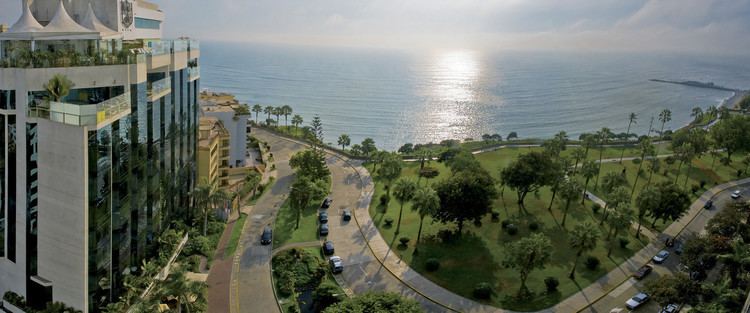Founded January 2, 1857 UBIGEO 150122 Elevation 79 m Local time Monday 5:37 PM | Time zone PET (UTC-5) Website miraflores.gob.pe Area 9.62 km² | |
 | ||
Weather 27°C, Wind S at 13 km/h, 71% Humidity Points of interest Huaca Pucllana, Larcomar, Parque del Amor, Kennedy Park, Miraflores Central Park | ||
Miraflores is a district of the Lima Province in Peru. It is an exclusive residential and upscale shopping district south of downtown Lima. It is also one of the most affluent districts that make up the city of Lima. It has various hotels (including the Hilton, the JW Marriott, and the Belmond), restaurants, bars, nightclubs, and department stores. Miraflores is one of the main tourist attractions in Lima.
Contents
- Map of Miraflores Peru
- Geography
- History
- Demographics
- Culture and education
- Economy
- Entertainment
- Costa Verde
- Education
- Sister cities
- References
Map of Miraflores, Peru
Founded as San Miguel de Miraflores, it was established as a district on January 2, 1857. As a result of the Battle of Miraflores fought during the War of the Pacific, Miraflores got the designation of Ciudad Heroica ("Heroic City"). The current mayor is Jorge Muñoz. The district's postal code is 18.
Geography
The district has a total land area of 9.62 km². Its administrative center is located 79 meters above sea level.
Boundaries
Climate Miraflores has a marine climate, characterized by mild, humid, and comfortable conditions. Temperatures oscillate from 13 °C (55 °F) to 18 °C (64 °F) in winter, and from 20 °C (68 °F) to 30 °C (86 °F) in summer. Low clouds are frequent, especially during winter, when morning drizzles are not uncommon. Heavy rain is almost unseen.
History
The only pre-Inca ruin remaining in Miraflores, Huaca Pucllana (formerly Hispanicized as Juliana) can still be seen. The Spanish town of Miraflores was established in the 16th century. However it was merged into the Lima Metropolitan Area as the city expanded during the early 20th century. During the War of the Pacific (1879–1885), the district was the scene of the Battle of Miraflores. Two thousand people died as a result and the district was sacked and burned by Chilean invaders.
Demographics
According to a 2002 estimate by the INEI, the district has 92,815 inhabitants and a population density of 9,648.1 persons/km². In 1999, there were 27,489 households in the district.
Culture and education
The district is also a cultural center, with theaters, cinemas and art galleries. It also has a pre-Inca mud-brick temple called the Huaca Pucllana, one of a number of archaeological sites found in Lima.
There are public and private schools in Miraflores. Schools are divide into Primary (grades 1-6) and Secondary School (grades 1-5). Because school is only 11 years the University education is 5 years (undergraduate). Some private schools in Miraflores are: Markham, Pestalozzi, Villa Maria Miraflores, Alexander Von Humboldt, St. George's College, Nuestra Señora del Carmen and María de las Mercedes. The school year start in March and end in December. The Humboldt I campus of the Deutsche Schule Lima Alexander von Humboldt (Colegio Peruano Alemán Alexander von Humboldt), a German international school, is located in Miraflores.
In terms of education, the Miraflores district lodges some of the most prestigious private schools in Peru, such as Markham College, and San Silvestre School (British schools), Deutsche Schule Alexander von Humboldt Lima [2](German school), and Pestalozzi [3](Swiss school. It also lodges the University of Piura and the Raúl Porras Barrenechea Institute of the National University of San Marcos.
Economy
Tourism dominates the economy of the district. LAN Perú has its headquarters in Miraflores. The former airline Aeroperú also had its headquarters in Miraflores.
Entertainment
The district is full of hotels, cafés, pubs, restaurants and shops, which draw large crowds of the local population on Sundays. Parque Kennedy, Miraflores' central plaza, regularly has flea markets and art exhibitions. Larcomar, a shopping mall overlooking the Pacific coast, is located in Miraflores, and is very popular among tourists, young people, and the middle and upper classes. There are restaurants, stores, a food court, ice cream shops, arcades, bowling alleys, nightclubs, bars, and the most modern cinema in Lima.
The main tourist attractions include La Huaca Pucllana, Kennedy Park, the church of the Miraculous Virgin (Iglesia Virgen Milagrosa), the Lover's Park (Parque del amor), Larcomar, and Calle de las Pizzas (Pizza Street). The Calle de las Pizzas, located in downtown Miraflores, is a favourite among the youth, foreigners and locals alike; it has many pubs, and as it name implies, offers not only drinks but also varieties of pizzas.
Miraflores has always been a major hub for tourists in Lima. There are a number of hotels in the area, including a couple of international hotel brands. Furthermore, there are several shops selling souvenirs and tourist products. The Miraflores Park Hotel is one of the district's five-star hotels.
Costa Verde
The Costa Verde ("green coast") area has several beaches, which draw surfers and beachgoers during the summertime. However, these rocky beaches are not as popular with bathers as the large, sandy beaches in the districts south of Lima, such as Santa María del Mar, Punta Hermosa, San Bartolo, Lurín and Punta Negra. La Marina Lighthouse is located on the cliffs overlooking the Costa Verde.
Paragliders launch from the coastal cliffs, providing there is enough wind.
Education
Private schools include:
The École Nouvelle/Escuela Nueva, now the Lycée Franco-Péruvien, was established in Miraflores in 1950. It moved to its current location in Monterrico in 1960.
